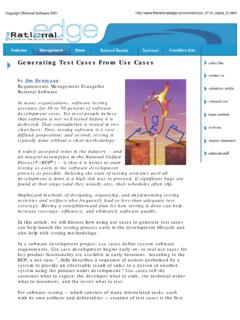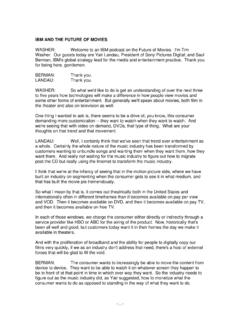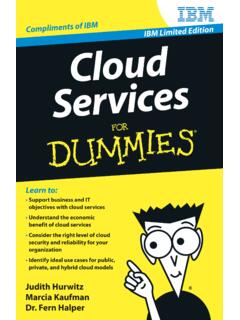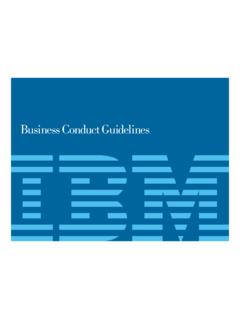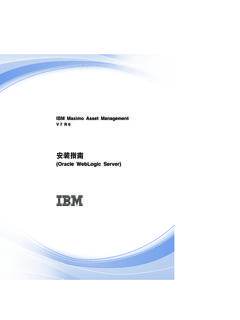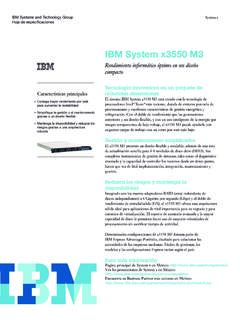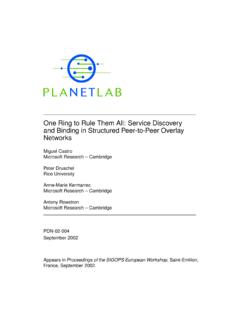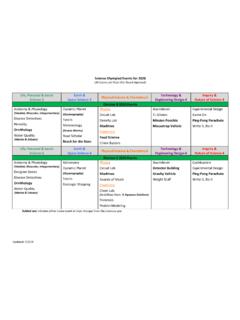Transcription of The Value of Training - IBM
1 IBM Training building skills for a smarter planet @IBMT raining The Value of Training Companies today need to drive performance from every aspect of their IT investments. Find out how skills drive performance results and how IBM is building skills for a smarter planet in partnership with IBM Global Training Providers IBM Training building skills for a smarter planet The Value of Training Introduction Top performing companies not only recognize the Today more than ever, companies need to maximize In this document, we will point to market drivers importance of their people but also the need to their human capital by providing the right skills at the and perform a reality check in the skills some provide the right skills to enable their people. 71% right time for the right people. Embracing the right organizations have and the market readiness to fill of CEOs cited human capital, ahead of products, level of IT Training , enablement and engagement the current and future skills gaps.
2 We show research customer relationships and brands as the leading can dramatically reduce attrition and safeguard the where more than 65% of global leaders cite talent source of sustained economic Value . In addition investment made in hiring. and leadership shortages as their #1 business CEOs ranked People Skills in top 4 External challenge and with some skill areas, a full 90% of forces impacting the enterprise . 84% of employees Employees who do not feel they can achieve their organizations do not have all the skills they need in Best Performing Organizations are receiving the career goals at their current organization are 12 times to be successful. We will look at the recommended Training they need compared with 16% in the worst more likely to consider leaving than employees action that companies can take to drive the right skills performing companies. who do feel they can achieve their career goals. Even and look at how to link Training to the business goals. worse, this number skyrockets to about 30 times We will review the benefits of a skilled workforce and more likely for new employees.
3 Considering the techniques to help you measure the ROI of Training . amount companies invest in the recruitment process and the time lost to filling the same role again, the impact to performance and margin can be significant. This paper outlines the gains your organization can achieve in client success, project success and adoption, product development, sales, risk manage- ment and retention and how you can measure the Source: IBM Smarter Workforce (Kenexa) 2013 Survey return on investment from a well designed skills building program that links your solution to your business needs. 2. IBM Training building skills for a smarter planet The Value of Training Table of Contents Introduction 2. Table of Contents 3. People and Skills: What Organizations Senior Management Think 4. The ROI of Training within your Organization 6. Today's organizations face new problems 11. Recommended action: Build skills internally 14. IBM Training : The New Model 17. 3. IBM Training building skills for a smarter planet The Value of Training People and Skills: What Organizations Senior Management Think Today, companies need to do everything possible The senior management inside organizations has to drive performance; people and skills are a strategic a clear idea that skills matter.
4 In the next section we part of this performance. The IBM C-suite Study 71% Of CEOs identified look at the Return On Investment (ROI) for Training . is a result of analyzing our conversations with human capital as a key source of 4,183 leaders in 70 countries. We spoke with a sustained economic Value Perceptions of new employee Training by cross-section of C-suite executives in more than job level 20 industries: This study offers insight into how It is clear senior management teams at successful these leaders view the world, their priorities and how Source: Leading through Connections IBM CEO Study, 2012 clients recognize the need for skills and Training . they are preparing for the future. In the study, CEOs There is a disconnect however between what the rank People Skills in the Top 4 external factors that In fact from 2004 through 2013 across all of the senior management believe is being delivered and will impact their business in the next 3 to 4 years. C-Level, people skills rank high on the list of what is actually being delivered.
5 External factors that will impact performance. People Skills Top 4 Focus Perceptions of new employee Training by job level CEOs Rank People Skills in top 4 External forces impacting the enterprise . Source: IBM C-Suite Survey 2013. In the prior year, 71% of CEOs cited human capital, ahead of products, customer relationships and brands Source: IBM Smarter Workforce 2013 Training and Tenure Report as the leading source of sustained economic Value . Source: Question E8 What are the most important external forces that will impact the enterprise over the next 3 to 5 years?; n=4,009. 4. IBM Training building skills for a smarter planet The Value of Training For example, an introductory sales course could Perceptions of new employee Training by HR role be evaluated by giving students a survey about or department the Training quality (reaction), by testing students on the content taught in the sales course (learning), by observing whether students actually end up using the sales tactics they learned (behavior), or by measuring changes in sales volume before and after Training (results).
6 By evaluating Training effectiveness and sharing those results across the company, organizations can close the gap between perceptions of managers, HR professionals and the rank-and-file. Source: IBM Smarter Workforce 2013 Training and Tenure Report Working with the management team to bridge the gap Decision-makers senior leaders and HR professio The Authorized IBM Global Training Providers have the nals seem to be a little more optimistic. Seven out of ability to work with IBM Clients to address all the needs 10 HR professionals believe employees are getting of the senior management team and client HR teams. the Training they need and that figure rises to eight out of 10 among senior leaders. Clearly a disconnect Linking Training to business needs One stop shop our IBM Global Training Providers exists between decision-makers and Training are not limited to just IBM Training , offering other recipients, perhaps resulting in under-investment IT technology Training , project management and in Training in many organizations.
7 Other related Training Skills gap analysis One solution for this disconnect may be a lack Driving Training effectiveness metrics and performance of objective Training performance metrics. According Hosting Learning Management Systems and integration to Dr. Donald Kirkpatrick, Professor Emeritus at into existing University of Wisconsin and Honorary Chairman of Kirkpatrick Partners, there are four ways to evaluate Training : reaction, learning, behavior and results. 5. IBM Training building skills for a smarter planet The Value of Training The ROI of Training within your Organization Best performing companies invest Relationship between number of hours Relationship between team skill and in Training of Training and project success. stakeholder objectives In a recent IBM Smarter Workforce study IBM The amount of Training does not need to be massive. Training helps stakeholders win: Objectives looked at best performing companies and worst When preparing for a project, teams receiving will be met 90% more often by increasing team performing companies to see if skills had a part to 40 hours of Training per member met their significant skills.
8 Increasing team skills by 1/3 increases play in performance. The results we found are not project objectives three times as often as teams likelihood of stakeholders meeting their objectives surprising: 84% of employees in Best Performing that received 30 hours of Training or from 10% to 100%.ii Organizations are receiving the Training they need, a full 68% better than worst performing companies. Relationship between number of hours of Training Relationship between team skills and and project success. stakeholder objectives Source: IBM Smarter Workforce 2013 Training and Tenure Report Source: IDC's Training Impact on Projects Survey, 2011. 6. IBM Training building skills for a smarter planet The Value of Training Benefits of a skilled workforce Building skills for a smarter workforce The benefits of a skilled workforce and a learning It pays to work smarter not harder. According Smarter working practices provide organizations solution are significant and measurable, and they to a 2010 study by the IBM Institute for Business with greater agility.
9 Affect all areas of the organization from sales and Value , organizations that are significantly outper- marketing to customer service and support. forming their industry peers also happen to be They include: making more headway on newer approaches to work. They are using dynamic, collaborative and 16% increase in customer satisfaction among connected ways of working to get things done companies using learning technologyiii effectively within a constantly changing environment. Skill levels linked to business Value , $70,000 in annual savings and 10% increase in productivity How can organizations work smarter? Through when teams are well trainediv IBM's interactions with clients around the world, 35% reduction in time spent searching for we have witnessed a number of practices that are Source: IBM Institute for Business Value A New Way or sales contentv making organizations more agile. These approaches Working 2010. 22% faster rollouts of products and processes to how work gets done fall into three main categories 75-80% of managers believe effective Training which make their organizations more: The IBM Institute for Business Value (IBV).
10 Is critical to project success and meeting research revealed several interesting findings: project deadlinesvii Dynamic adjusting rapidly to changing business conditions Outperformers use smarter working practices far Collaborative bringing together resources, more extensively than their lower-performing peers both internal and external, to share insights and and they are doing so to fuel growth, not just 75-80% of managers believe solve problems drive efficiency. effective Training is critical to project Connected enabling access to information For most organizations, the ability to adapt to success, skill levels linked to regardless of time, distance or organizational silos a constantly changing environment is hampered by capability gaps in three primary areas: process business Value yield a 10% increase and skill reconfiguration; broader and more in productivity embedded collaboration and integrated, real-time information for decision-making. The most dynamic, collaborative and connected companies have widely adopted certain technolo- gies that make smarter working practices viable.
